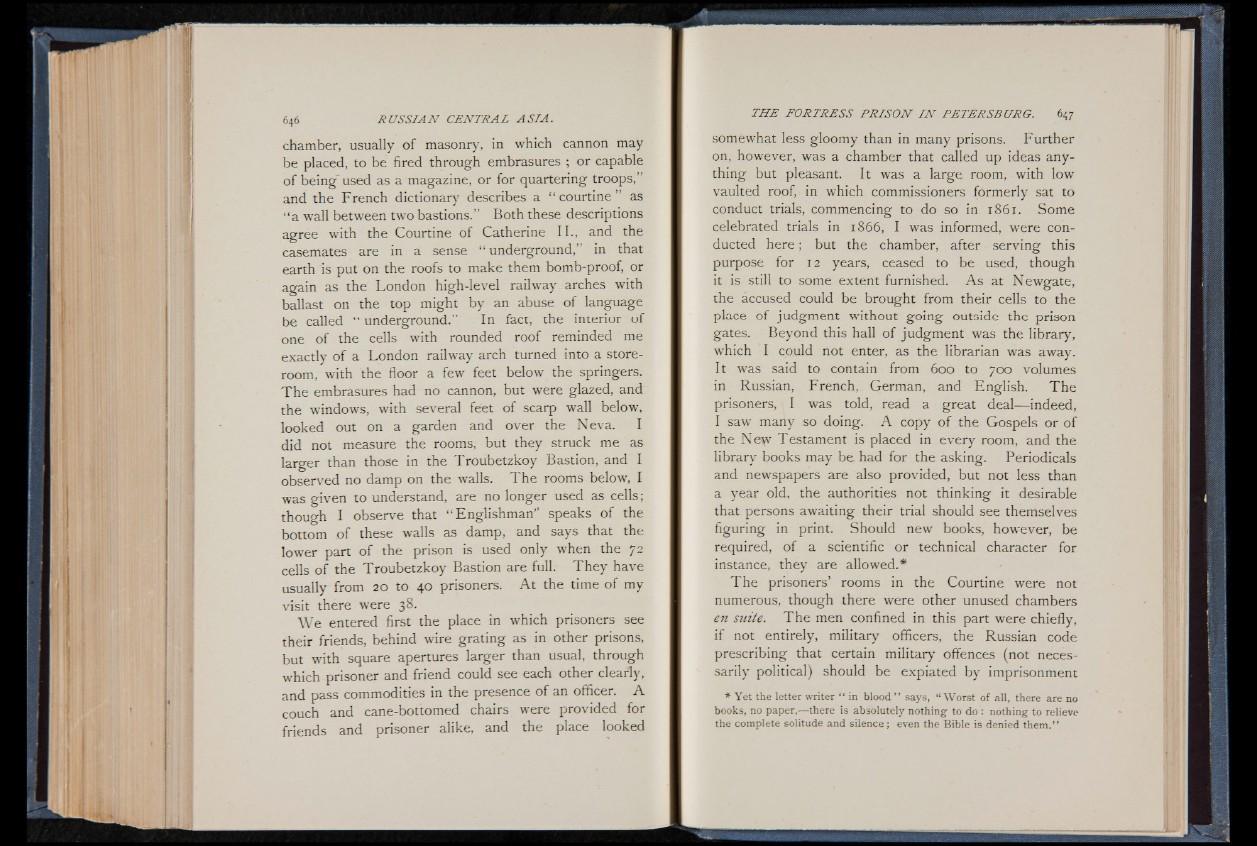
chamber, usually of masonry, in which cannon may
be placed, to be fired through embrasures ; or capable
of being used as a magazine, or for quartering troops,”
and the French dictionary describes a “ courtine ” as
“ a wall between two bastions.” Both these descriptions
agree with the Courtine of Catherine II., and the
casemates are in a sense “ underground,” in that
earth is put on the roofs to make them bomb-proof, or
again as the London high-level railway arches with
ballast on the top might by an abuse of language
be called “ underground.” In fact, the interior of
one of the cells with rounded roof reminded me
exactly of a London railway arch turned into a storeroom,
with the floor a few feet below the springers.
The embrasures had no cannon, but were glazed, and
the windows, with several feet of scarp wall below,
looked out on a garden and over the Neva. I
did not measure the rooms, but they struck me as
larger than those in the Troubetzkoy Bastion, and I
observed no damp on the walls. The rooms below, I
was given to understand, are no longer used as cells;
though I observe that “ Englishman” speaks of the
bottom .of these walls as damp, and says that the
lower part o f the prison is used only when the 72
cells of the Troubetzkoy Bastion are full. They have
usually from 20 to 40 prisoners. A t the time of my
visit there were 38.
W e entered first the place in which prisoners see
their friends, behind wire grating as in other prisons,
but with square apertures larger than usual, through
which prisoner and friend could see each other clearly,
and pass commodities in the presence of an officer. A
couch and cane-bottomed chairs were provided for
friends and prisoner alike, and the place looked
somewhat less gloomy than in many prisons. Further
on, however, was a chamber that called up ideas anything
but pleasant. It was a large room, with low
vaulted roof, in which commissioners formerly sat to
conduct trials, commencing to do so in 1861. Some
celebrated trials in 1866, I was informed, were conducted
h e re ; but the chamber, after serving this
purpose for 12 years, ceased to be used, though
it is still to some extent furnished. As at Newgate,
the accused could be brought from their cells to the
place of judgment without going outside the prison
gates. Beyond this hall of judgment was the library,
which I could not enter, as the librarian was away.
It was said to contain from 600 to 700 volumes
in Russian, French, German, and English. The
prisoners, I was told, read a great deal— indeed,
I saw many so doing. A copy of the Gospels or of
the New Testament is placed in every room, and the
library books may be had for the asking. Periodicals
and newspapers are also provided, but not less than
a year old, the authorities not thinking it desirable
that persons awaiting their trial should see themselves
figuring in print. Should new books, however, be
required, of a scientific or technical character for
instance, they are allowed.*
The prisoners’ rooms in the Courtine were not
numerous, though there were other unused chambers
en suite. The men confined in this part were chiefly,
if not entirely, military officers, the Russian code
prescribing that certain military offences (not necessarily
political) should be expiated by imprisonment
* Y e t the letter writer “ in blo od ” says, “ Worst of all, there are no
books, no paper,— there is absolutely nothing to do : nothing to relieve
the complete solitude and silen ce ; even the Bible is denied them.”